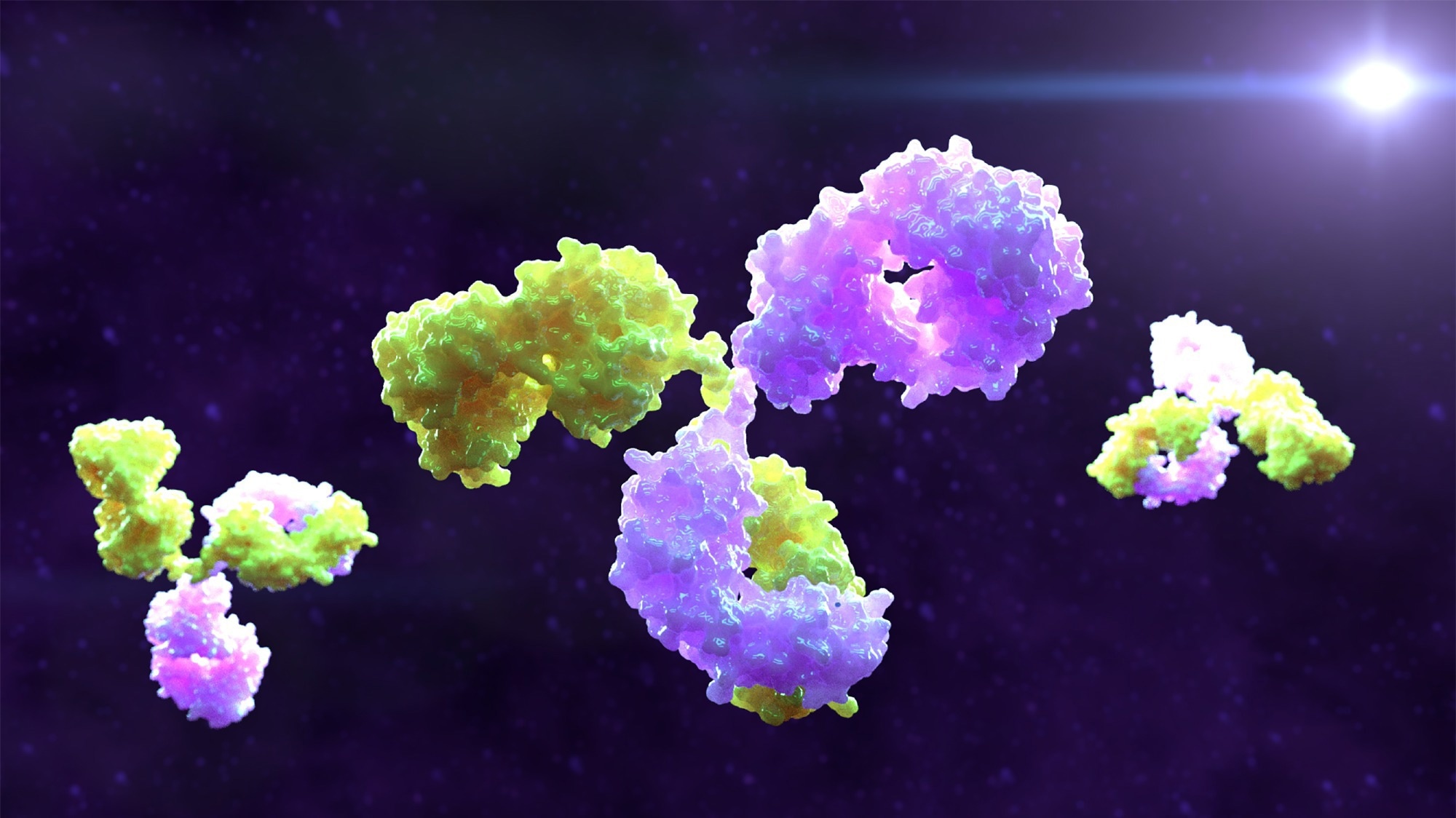Bispecific antibodies neutralize Sarbecoviruses with increased breadth and potency
In a recent study posted to the bioRxiv* preprint server, researchers developed bispecific antibodies (bsAbs), neutralizing severe acute respiratory syndrome coronavirus 2 (SARS-CoV-2) variants.
SARS-CoV-2, the causal agent of the coronavirus disease 2019 (COVID-19) pandemic, has, to date, caused more than 633 million cases and over 6.5 million deaths globally. Although SARS-CoV-2 has a low fatality rate, it is much more transmissible than SARS-CoV-1, which is also from the same Sarbecovirus sub-genus. Notwithstanding the high efficacy of COVID-19 vaccines, there is a need for additional therapeutic options, particularly for some at-risk populations, such as immunocompromised adults.
Most neutralizing antibodies (nAbs) target the spike protein’s receptor-binding domain (RBD). Antibodies can bind to one or two RBDs on a single spike trimer through their two-fragment antibody-binding (Fab) arms. bsAbs are multivalent constructs that contain two Fab arms binding to different spike epitopes. bsAbs show improved resistance to emergent SARS-CoV-2 variants than monospecific nAbs.
 Study: Bispecific antibodies combine breadth, potency, and avidity of parental antibodies to neutralize sarbecoviruses. Image Credit: Alpha Tauri 3D Graphics / Shutterstock
Study: Bispecific antibodies combine breadth, potency, and avidity of parental antibodies to neutralize sarbecoviruses. Image Credit: Alpha Tauri 3D Graphics / Shutterstock
The study and findings
In the present study, researchers developed bsAbs from individual nAbs isolated from individuals infected with the SARS-CoV-2 Wuhan Hu-1 strain. bsAbs were generated by combining less potent nAbs COVA1-16 and COVA2-02 with highly potent COVA2-15 and COVA1-18 using a controlled Fab arm exchange (cFAE) method. Through a redox reaction, this technique can rapidly produce bsAbs from two parental immunoglobulin G 1 (IgG1) molecules. In addition, the less potent nAbs also show cross-reactivity with SARS-CoV-1.
Each parental IgG1 molecule contained a mutation (F405L or K409R) in its fragment crystallizable (Fc) arm to allow heterodimerization. These mutations did not affect antibody-dependent cellular trogocytosis (ADCT), phagocytosis (ADCP), or pseudovirus neutralization. Biolayer interferometry (BLI) and enzyme-linked immunosorbent assay (ELISA) confirmed that cFAE yielded bona fide bsAbs and not a cocktail of monospecific antibodies.
The authors generated “dead arm” bsAbs by combining COVA nAbs with an antibody specific to the hepatitis C virus (HCV). These constructs of the size of an IgG essentially had only a single Fab. The binding of bsAbs containing an irrelevant/dead Fab (IgG+-) to the spike proteins of Wuhan-Hu-1, Beta variant, and SARS-CoV-1 was compared using BLI relative to their parental counterparts (IgG++). IgG+- nAbs had lower binding to the Wuhan-Hu-1 spike protein, and this effect was more pronounced for the Beta variant.
Next, the researchers conducted BLI measurements of COVA1-16/2-02, COVA2-02/2-15, and COVA1-16/2-15 bsAbs to the spike protein of SARS-CoV-2 Wuhan-Hu-1, Beta variant, and SARS-CoV-1. These bsAbs retained binding to the tested spike proteins. The bsAbs containing the COVA2-02 Fab arm exhibited substantial binding to the SARS-CoV-1 spike, despite the other Fab arm (COVA02-15) not contributing to this interaction.
Lab Diagnostics & Automation eBook

The authors relied on mass photometry (MP) to assess the binding characteristics of bsAbs, monospecific antibodies, and corresponding “dead arm” bsAbs to the spike trimer. The COVA1-16 nAb was preferentially bound in a 1:1 IgG:spike trimer stoichiometry, whereas COVA2-02 was bound in a 2:1 stoichiometry. For the bsAbs, the observed stoichiometry of the IgG:spike trimer was 3:1, which was not identified for any COVA nAbs.
The neutralizing activity of antibodies was assessed using pseudoviruses. The dead arm COVA1-16 and COVA2-02 bsAbs lost neutralization against SARS-CoV-1, SARS-CoV-2 Wuhan, and Beta variant. In contrast, the dead arm COVA2-15 and COVA-18 bsAbs were 11- and 30-fold less potent against SARS-CoV-2 Wuhan-Hu-1 than their monospecific counterparts, suggesting the substitution of a Fab arm with an irrelevant Fab caused significant declines in neutralization potency.
Finally, the neutralizing potency of bsAbs was evaluated by comparing the potency and breadth of monospecific COVA antibodies against SARS-CoV-2 Wuhan-Hu-1, its mutant variants, and SARS-CoV-1. The monospecific COVA1-16 exhibited broad neutralizing activity against Wuhan-Hu-1 and mutants such as D614G, Alpha, Beta, Gamma, Delta, and Omicron variants. COVA2-02 weakly neutralized SARS-CoV-2 but had similar potency as COVA1-16 against SARS-CoV-1.
COVA2-15 neutralized Wuhan-Hu-1, Alpha, and D614G variants but failed to neutralize Omicron subvariants. The COVA1-16/2-02 bsAb was marginally less potent than the COVA1-16 monospecific antibody but more than COVA2-02 alone. It consistently neutralized all tested pseudoviruses at varying half-maximal inhibitory concentrations (IC50). The COVA1-16/2-15 bsAb increased neutralizing potency and breadth relative to COVA1-16 and COVA2-15 monospecific antibodies, respectively.
The COVA2-02/2-15 bsAb similarly showed improved potency and breadth relative to its monospecific counterparts. However, this bsAb had weak neutralization activity against SARS-CoV-2 Beta, Gamma, Delta, and Omicron and did not neutralize Omicron BA.1. Notably, the COVA2-02/2-15 bsAb exhibited four-fold improved potency against SARS-CoV-2 Delta than a cocktail of COVA2-02 + COVA2-15 monospecific antibodies.
Conclusions
In summary, the study demonstrated the generation of different bsAbs using SARS-CoV-2 nAbs isolated from convalescent individuals. The bsAbs neutralized all tested variants of SARS-CoV-2 but with varying potencies. Though bsAbs and antibody cocktails showed comparable neutralizing potencies, bsAbs had higher binding stoichiometries than antibody cocktails. Overall, the results underscored the significance of broad pan-Sarbecovirus nAbs targeting conserved epitopes to generate multivalent antibody constructs that resist viral escape by mutant SARS-CoV-2 variants.
*Important notice
bioRxiv publishes preliminary scientific reports that are not peer-reviewed and, therefore, should not be regarded as conclusive, guide clinical practice/health-related behavior, or treated as established information.
- Radić L, Sliepen K, Yin V, et al. Bispecific Antibodies Combine Breadth, Potency, and Avidity of Parental Antibodies to Neutralize Sarbecoviruses. bioRxiv, 2022. DOI:10.1101/2022.11.11.516125, https://www.biorxiv.org/content/10.1101/2022.11.11.516125v1
Posted in: Medical Science News | Medical Research News | Disease/Infection News
Tags: Antibodies, Antibody, Assay, Coronavirus, Coronavirus Disease COVID-19, covid-19, Efficacy, ELISA, Enzyme, Hepatitis, Hepatitis C, Immunoglobulin, Molecule, Mutation, Omicron, Pandemic, Phagocytosis, Protein, Pseudovirus, Receptor, Respiratory, SARS, SARS-CoV-2, Severe Acute Respiratory, Severe Acute Respiratory Syndrome, Spike Protein, Syndrome, Virus

Written by
Tarun Sai Lomte
Tarun is a writer based in Hyderabad, India. He has a Master’s degree in Biotechnology from the University of Hyderabad and is enthusiastic about scientific research. He enjoys reading research papers and literature reviews and is passionate about writing.
Source: Read Full Article
